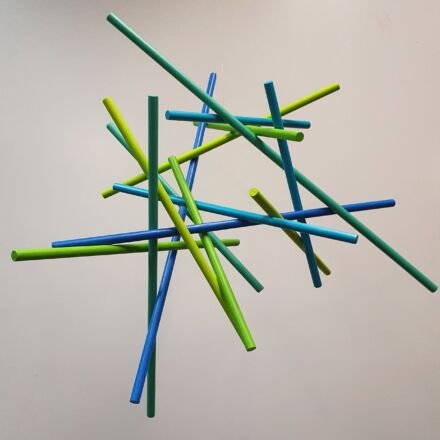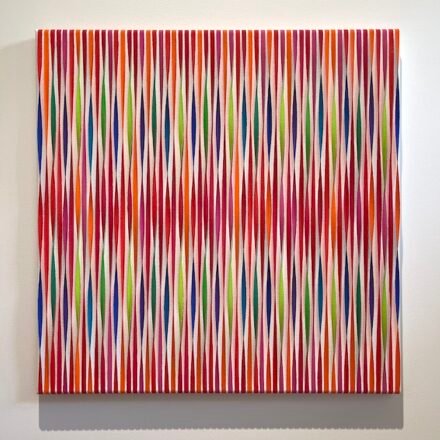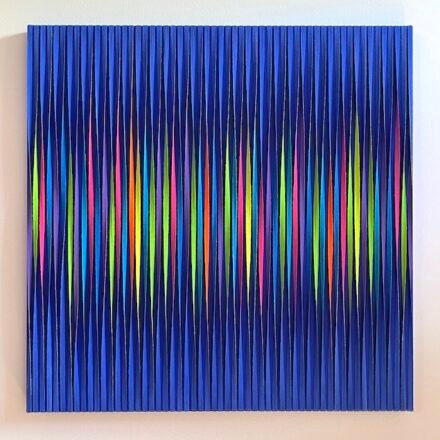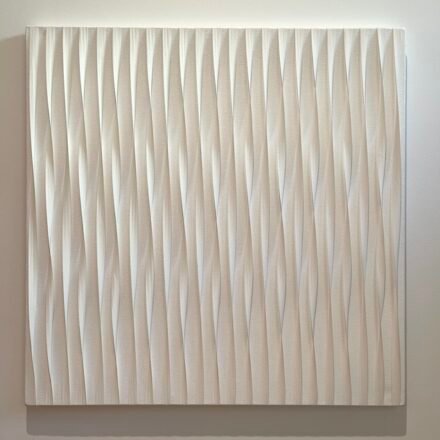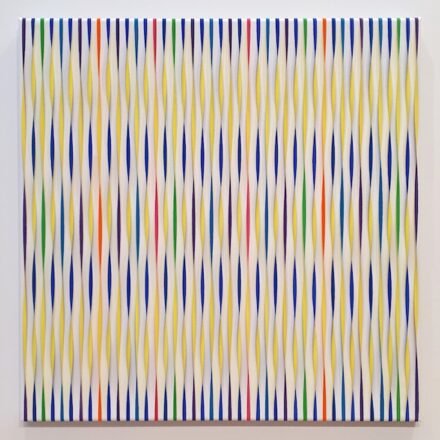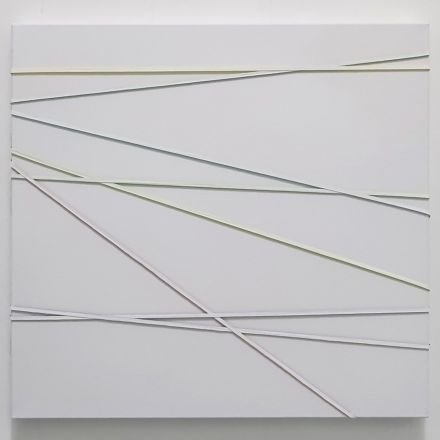As part of the Inner West Council Creative Trails program, I took part in the July Secret Studios tour this year.
In order to show people my work, we walked everyone through the house, where we have some of my older more formative pieces hanging. Then we took them out to the studio, where I shared a few insights about creativity. The tour was well-attended, so the studio was overflowing.
I was very glad to have the opportunity to take a step back and think about this question of creativity. The presentation was a mix of notes I prepared earlier and things that occurred to me on the spot. Here are some of the prepared notes:
Creativity
Firstly, let’s clear the air of a few myths.
Creativity is not…
…art – the sciences, politics and many other fields also depend on creativity
…good – torturers can be very creative
…always exhilarating – it can be, but sometimes it’s scary, and often it’s plain old hard graft
…productivity – although you can be creative about that, too
…spontaneity – creativity always has a context, even if it is just the language being used
…genius – there is no spirit or faculty of creativity. Yes, some people are more creative than others, but those others can always be more creative than they are
…knowledge – to know things is to nail them down
…any guarantee of commercial success – see productivity
The Rules of Creativity
Of course, the first rule of creativity is:
There are no rules.
Actually that isn’t the rule. But it sounds good.
To me, the first rule of creativity is that you make your own rules.
For artists there are plenty of rules imposed by the limitations of their medium or process, or just by what interests them. Discovering those rules, testing them, trying new ones, is a key part of the creative process. And it can be a lot of fun. It’s often referred to as experimentation, but I don’t use that word as it sounds like you’re trying to be scientific.
It might seem that to be creative means you go around looking for rules to break. This is a bit of a hit-and-miss approach, and you run the risk of eventually retreating to the safest, least creative job you can find. In any event:
New rules will always spring up to replace the old ones.
Best to not even think about the rules. This is what you do in brainstorming, which takes place in specific sessions, within which participants just accept all ideas. Nothing is too lame.
That’s the rule: Nothing is too lame.
Brainstorming sessions are a bit like getting stoned – your inner sensible person is switched off and you get this flood of inspired, amazing ideas. With drugs, however, when you go back into the studio the next day and find all your scribblings and scrawlings, they suddenly don’t seem all that amazing really, plus your brain is so addled you’re really not sure.
So, sorry but: Don’t do drugs.
Often an idea will come into your brain and interfere with what you have to get done right now. If you’re like me, and more than a little ADHD, whole weeks can be derailed by a random thought you can’t resist. Resist it. Best way to do that, as in brainstorming, is to record it:
Get it down.
Your diary is your own personal space full of your own personal crap. It always amused me at art school that you had to present your Visual Diary to be evaluated. It doesn’t work like that. You may be very proud of your beautiful journal, full of amazingness, but if you’re editing it for public consumption it’s not going to work. You’ll either inhibit yourself, or twist your ideas to fit what you think is going to be impressive.
Find what works for you.
I am constantly starting new diaries and getting in a mess, so I’ve ended up putting everything into my task manager app, which is connected to my calendar, so when I’m setting up a new project I can easily look up my ideas. My system isn’t perfect – I spend way too much time organizing my organizing – but as you settle on a system it does get more frictionless.
My next rule may seem counter-intuitive, because creativity is supposed to be all about freeing yourself of all your mental blocks. But there is no point just having a million ideas: they have to be doable, and they may as well be worth doing. The evaluation process involves different parts of the brain to brainstorming, and triggers different kinds of responses, so it needs to take place separately. Again, find the way that works for you, but:
Don’t silence your inner critic.
The more you avoid evaluation, the more monstrous will be the return of the repressed. You want to tame your inner critic. Like a dog, teach it when it’s appropriate to bark and when not. Set aside time for walkies, reward it with your attention. Train it to behave properly and your critical voice will go from constant nuisance to loyal best friend.
And it is a friend you really ought to listen to. You need to be like the sculptor hammering at a block of stone – always listening to what the stone is saying before that one wrong blow. Don’t wear your headphones.
If you’re having trouble getting on top of it, if your critical friend is really your enemy, constantly repeating junk thoughts like: “You’ll always be shit”, “You’ll never get there” or “You’re just hopeless,” then you need to take it back to puppy school. See your doctor and get a referral to a psychologist.
Final thoughts
I get a lot of inspiration from the ancient Greek philosopher Heraclitus. Although we don’t know that much about him, we do know some of the things he said. Most famously: “You can’t step into the same river twice”. Which is pretty cool. It’s never the same river because the water in it is always different. Everything is in flux.
But there is another source for this quote, which reads a bit differently:
“Upon those that step into the same rivers different and different waters flow…”
So here we are right now, standing in the same river, but experiencing different waters. As well as everything being in flux, the phenomena we experience is particular to each of us. In a way, this means we are each physically in different worlds. Standing in front of the same picture, different rays of light bounce off it to land on our retinas. We see the same picture, but our seeing is different.
And yet, we are standing in the same river. How things happen, how it all comes about, the logic of things, is common. Even the uniqueness of our experience is common. And that’s the first thing to grant ourselves, and others, if we want to be creative.
Since the days of Heraclitus, philosophers and scientists have engaged in the project of searching out this common, developing a model of the world, a shared understanding. Although it is never completely coherent, and new problems are always being thrown up, it is indeed a staggering achievement.
In its own way, and also by a process of modelling, art does something similar. But I would suggest that, unlike science, which aims for a single model of the real world, each individual work of art is a model of its own world. Each artwork takes what it needs from the real world, to be communicable, but develops a fiction whose truth consists in the way it chimes with our own unique experience of the world.
Art and science both harness creativity to pursue their projects – and intrinsic to the process is this modelling. To manage our experience of the world, we develop our own personal mental model of it, and much of our energy in life is spent building, maintaining, adjusting and sometimes radically altering this model, to keep it coherent, consistent – both internally and against what others might propose When the world presents something to us that we can’t readily accommodate, our creativity swings into action. We do the research, we try out different ways to assimilate the new information.
Or not. Often, to protect ourselves, we put more effort into shutting out the new information, as if our lives depend on the model always holding. If your model becomes incoherent, eventually so do you. But the more practiced you are at growing, changing, altering your model, the greater its integrity will be – and the more practiced will be your creativity.
Another well-known quote from Heraclitus is:
“If you do not expect the unexpected, you will not find it…”
This is key to creativity. As an artist, you often progress by a series of hunches. You are always tracking what you’re doing to see if it’s going the way you expected, and adjusting one way or another when it doesn’t. But just because something isn’t what you expected, that doesn’t mean it should be disregarded. Don’t let the expected blind you to inspiration.
In order to expect the unexpected, it helps to unexpect the expected.
Works
Showing all 12 resultsSorted by latest


